Updated: 08-Jan-2020
Leon Levavasseur was the creator of an important engine around 1904, for its shape, power and design.
-Being destined to power canoes, it attracted the attention of Mr. Gastambide and they founded "Societe Antoinette" to build engines for aeronautical use.
-The company's name was a tribute to the the senior partner's daughter, Antoinette Gastambide.
-The first engine that came out around 1905 was a V-8 with 24 CV.
-The engine's overall appearance is maintained throughout the models that followed.
-The eight cylinders are in V at 90° with red copper casings (cuivre rouge). They are water cooled and have superposed aluminum cylinder heads, water pump, carburetor and magneto.
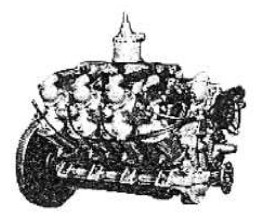
“Antoinette 24 CV”
-The next year, 1907, the 50 hp came out as a result of coupling two 24 CV engines. This was a formula that they already used in sports boats.
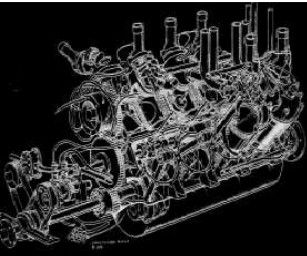
“Drawing, 50 CV” (PiP)
-We see an impressive drawing of Frank Hunger, made in 1998.
-The illustrations could raise misunderstanding, for the size of these engines was rather small.
-According to documentation of that time, the evolution of the engines was as follows:
-The V8 engines were mainly divided in four families. The 20/24 CV obtained its power at 1,600 rpm with 80 mm piston diameter and 80 mm stroke.
-It weighed only 40 kg and was 600 mm long, 450 mm wide and 390 mm high.
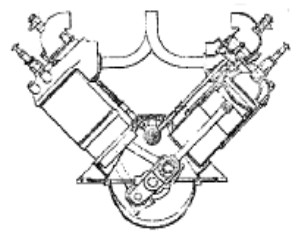
“Antoinette, diagram”
-The carburetor is substituted by an incipient injection system.
-Maintaining the controlled exhaust valve and the automatic intake valve.
-The 40/50 CV engine with 8 cylinders is from 1907/1909. Its power was obtained at 1,400 rpm.
-The characteristic of Antoinette engines is that their cylinder's bores have the same size as their strokes. Today we would say "square".
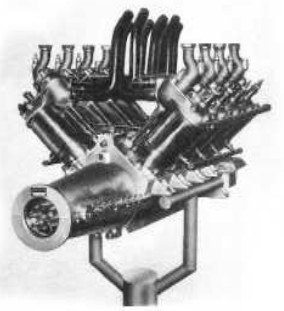
“Antoinette 40 CV”
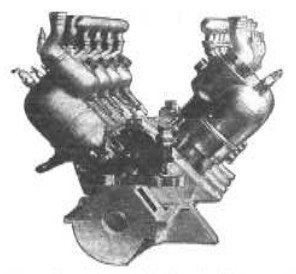
“Antoinette 50 CV”
-In this photo of "Les Merveilles de la Science" we see the cylinders' change, more integral. Each cylinder has a size of 105 by 105 mm.
-These engines were 800 mm long, 620 mm wide and 550 mm high.
-The 100 CV V-8 had a piston diameter of 150 mm with a 150 mm stroke. It was 1,056 mm long.

“Antoinette with transmission”
-Above we show the 50 CV version with transmission, possibly for boats or airships.
-The direct injection system on the inlet bend of each cylinder through calibrated nozzles, consisted of a gasoline piston-pump that could be adjusted by the pilot.
-Below we show a couple of views of the engine that appeared blurred in another part of the main text.

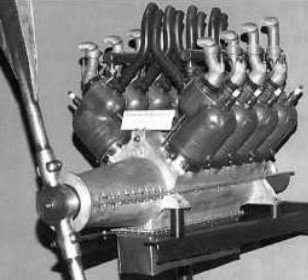
“Two views of the Antoinette V8”
-In these two photographs we see the rectangular oil tank under the engine, which is not seen in any other of the brand's models.
-The 45 CV was mounted in the Breguet-Richet. There was a 55 CV.
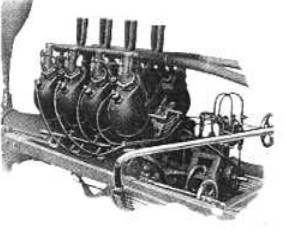
"Antoinette 55 CV"
-With a 60 CV engine on the Levavasseur-Antoinette "monobloc" aircraft, an altitude record was obtained in August 1909: 155 meters. This already is a 16-cylinder, or two coupled V-8 engines.
-Generally, Antoinette engines that had the cylinders in an angle of 90° had the connecting rods and pistons coinciding on the same crankpin.
-And also, the shape of exhaust pipes and intakes made the engine having a beautiful shape, like in the illustration below.

"Antoinette V-8”
-The cooling system was "evaporative", ie the water was boiling within the cylinders. Pumps and radiators or large side panels along the fuselage returned the steam to its liquid state, as shown in Angelucci-Matricardi's drawing below.
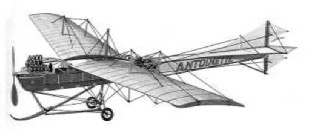
"Antoinette-Lavavasseur with V-8"
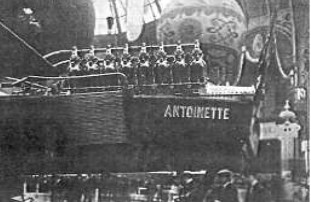
Antoinette-Levavasseur with V-16
-The first 16-cylinder version was created by joining two 24 CV engines obtaining 50 CV. There was the 67 CV joining two 32 CV V-8 engines. With two 50 CVs they reached 100 CV.
-Probably this photography of the 1907 Paris Air Show corresponds to the 100 CV V-16 engine. We see the radiator's "honeycombs" attached to the fuselage.
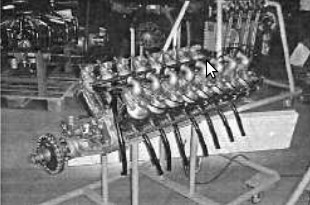
"Antoinette at the MAE"
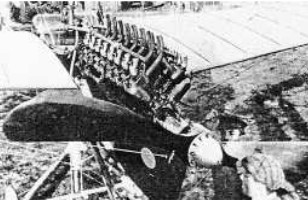
"An Antoinette 16-cylinder in a Latham"
-We have evidence of 24-cylinder versions, but we have not been able to confirm other information that mentions a 32-cylinder engine.
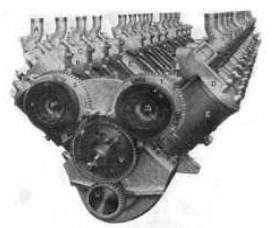
"Antoinette 24 cylinders"
-The 24-cylinder shown here is not intended to go in an aircraft but in a sports boat. (1907).
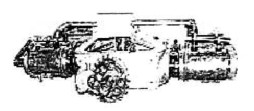
"Antoinette boxer"
-An engine that dates from 1909 and attributed to Antoinette has been found in The Central Museum of the Air Forces at Monino, Russia. It is a water-cooled, horizontally-opposed, 4-cylinder boxer engine with chain drive.
From appendices 2, 4 and 6: As we know from the main text, the name "Antoinette" comes from the daughter of Jules Gastambide, Leon Levavasseur's partner. Both partners were in construction of aircraft and engines.
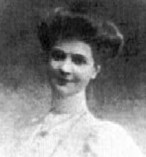
“Antoinette Gastambide”
-And rather than aircraft, Antoinette engines became famous in the first stage of motorized flight.
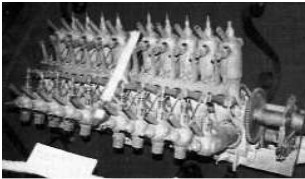
"20-cylinder Antoinette"
-In above photo we see a curious 20-cylinder, aeronautical Antoinette engine as the result of joining two equally curious 10-cylinder engines.
-As we know a 10-cylinder V-engine has its blocks in an angle of 72° for regular operation so that the geometric angle matches the combustion angle.
-So, normally a 12-V has an angle of 60°. A V-8 has a 90° angle, and a 6-V should have an angle of 120°.
-Remember that the combustion angle in a four-stroke engine is two turns of the crankshaft divided by the number of cylinders: (2 x 360: nr= ?). If this coincides with the geometric angle between the cylinders, even better.
-And now an Antoinette with a device in the extension of the exhaust pipes.

"Gastambide -LH- and engineer Mangin -RH-"
-Mangin was the designer of the monoplane "Antoinette" in 1908. Below there is a photo that shows the testing of a 100 CV, V-16 engine destined for the Santos-Dumont number 18. It turned out to be heavy.

"The Antoinette 16V"

The 16V (or V16, indistinctly"")"
-The engine exhibited at the Museum of Science and Technology of Milano has a rather complicated intake manifold to the cylinder because all the intakes are combined into one. However, the exhausts remain individual.

"An Antoinette V8 in Milano"
-Below we will display a little-known illustration of the engine's extravagant water-cooling system, from the top of the cylinder heads to the radiators located next to the fuselage.
-What calls our attention, is the length of the air ducts, without being fastened for the vibration that they should be suffering. Do not forget that the engines were mounted directly on the wooden bench without shock absorbers. And a running engine was not exactly smooth those days.

"Curious installation of an Antoinette"
-The mentioned lateral condenser (radiator) was used to convert any vapor, which might have been formed inside the cylinder liners, into water.
From appendix 9: The engines were simply known as "Antoinette" ignoring the designer Levavasseur.
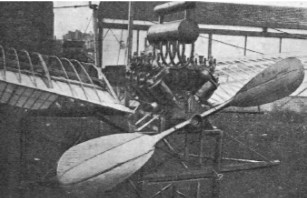
"Antoinette on a Mengin-Gastambide"
-The photo is from 1908 and the big tank is the cooling-water condenser.
From appendix 10: I always remember this photograph of Santos Dumont in his plane with an Antoinette-Levavaseur engine. A magnificent photo I found in the Cartier catalog, for their specific "Santos" watch, dedicated to his memory.

"Santos' plane with the Antoinette engine"
-It is interesting to see the collectors above the engine and the two water radiators, very light, on both sides of Santos Dumont.
-Below we show an anthological photo of a man, who, during a lightness demonstration of early aircraft engines (compared with automotive and industrial engines), holds a 16-cylinder V-engine on his shoulder. An engine that was made by coupling two V8s.

“From an old publication” (PiP)
In the American Ashmusen chapter there is a reference to an Antoinette engine -a 24 CV- that runs in reverse with a simple operation that is turning a small wheel at the end of the camshaft.
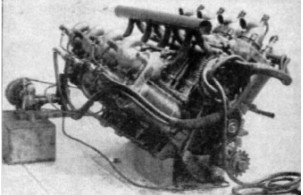
"Modelo de Antoinette con giro reversible"
-The author has failed to identify the device in the previous picture. The text continues to report as follows: In the same way as a steam engine can do it, changing the cam position with respect to the inlet and outlet valves. (Similar to Stephenson's solution for his steam engine).
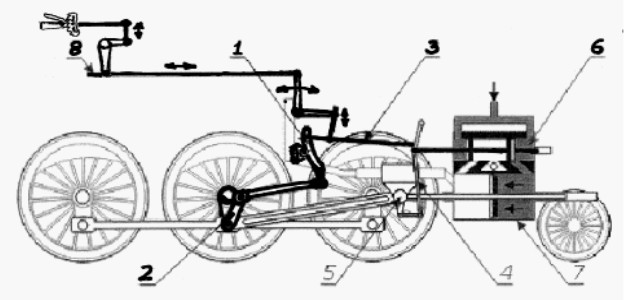
"Stephenson's reverse operation solution for his steam engine"
The driver moves the lever (8). If it is in the center, the valve (in this case Walshaert type) will also be centered (3) through a rocker (1), cutting the steam flow into the power cylinder. When the lever is out of this position (as we see in the movies) the distribution valve let pass a small amount and if it is moved much more from the center, which is the example case, it will let through more steam, thus regulating and increasing speed.
-If the driver has moved the lever in one direction, the machine moves forwards. If he moves it the opposite direction the machine runs backwards. The key mechanism is the banana shaped rocker with an elongated hole.
-Similarly in the Antoinette we put the exhaust valve cam (the intake valve is automatic) in the exhaust or compression stroke. This happens when lifting a catch, turning the thumbwheel and relocating the catch. So easy: a reversible engine.
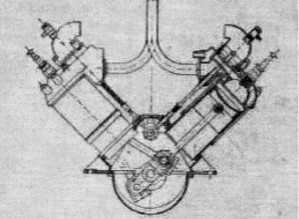
"The automatic intake valve, on top"
Certain V8 engines of this brand designed by Levavasseur had a reversible rotation system. This was done by changing the position of a pin in the camshaft gear. The author was able to handle one on the 24 CV engine in the Bermuda hangar at the MAE.
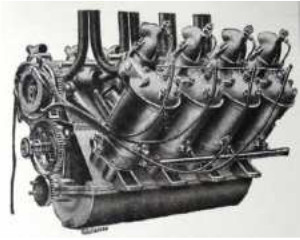
"Visible reversible rotation mechanism"
-From what could be discovered, the double version of the previous engine kept this original and interesting mechanism. As is known, only the exhaust valve is operated because the intake valve is automatic.
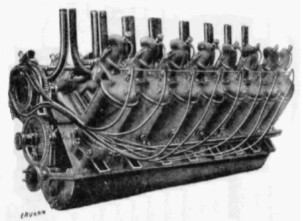
"V-16, also reversible rotation"
-Other models of this brand do not have this mechanism. It was supposed to be to enable the engine's installation with pull and push propellers.
Engines of ANTOINETTE LEVAVASSEUR
Model: 4-cylinder boxer

"Antoinette boxer"
Model: V16, 100 CV (x2 de 50 CV)
Model: V16, 40 CV

"Antoinette 40 CV"
Model: V16, 50 CV (x2 de 24 CV)
Model: V16, 60 CV
Model: V20

"Antoinette 20 cylinders"
Model: V24, 150 CV (x3 de 50 CV)

"Antoinette 24-cylinder"
Model: V8, 100CV
Model: V8, 24 CV

"Antoinette 24 CV"
Model: V8, 45 CV
Model: V8, 50 CV

"Antoinette 50 CV"
Model: V8, 55 CV

"Antoinette 55 CV"


